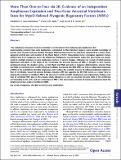Files in this item
More than one-to-four via 2R : evidence of an independent amphioxus expansion and two-gene ancestral vertebrate state for MyoD-related Muscle Regulatory Factors (MRFs)
Item metadata
| dc.contributor.author | Aase-Remedios, Madeleine Emma | |
| dc.contributor.author | Coll-Lladó, Clara | |
| dc.contributor.author | Ferrier, David Ellard Keith | |
| dc.date.accessioned | 2020-07-23T16:30:03Z | |
| dc.date.available | 2020-07-23T16:30:03Z | |
| dc.date.issued | 2020-10 | |
| dc.identifier | 268335520 | |
| dc.identifier | a46809fe-ff92-4abf-b1b0-7f60ec74eb96 | |
| dc.identifier | 85092680665 | |
| dc.identifier | 000593115800015 | |
| dc.identifier.citation | Aase-Remedios , M E , Coll-Lladó , C & Ferrier , D E K 2020 , ' More than one-to-four via 2R : evidence of an independent amphioxus expansion and two-gene ancestral vertebrate state for MyoD-related Muscle Regulatory Factors (MRFs) ' , Molecular Biology and Evolution , vol. 37 , no. 10 , pp. 2966-2982 . https://doi.org/10.1093/molbev/msaa147 | en |
| dc.identifier.issn | 0737-4038 | |
| dc.identifier.other | ORCID: /0000-0003-3247-6233/work/77893630 | |
| dc.identifier.uri | https://hdl.handle.net/10023/20324 | |
| dc.description | Funding: Madeleine Aase-Remedios and Dr Clara Coll-Lladówere supported by funding from the University of St Andrews, School of Biology and additional support from the CORBEL grant European Research Infrastructure cluster project. | en |
| dc.description.abstract | The evolutionary transition from invertebrates to vertebrates involved extensive gene duplication, but understanding precisely how such duplications contributed to this transition requires more detailed knowledge of specific cases of genes and gene families. MyoD (Myogenic differentiation) has long been recognized as a master developmental control gene and member of the MyoD family of bHLH transcription factors (Myogenic regulatory factors, MRFs) that drive myogenesis across the bilaterians. Phylogenetic reconstructions within this gene family are complicated by multiple instances of gene duplication and loss in several lineages. Following two rounds of whole genome duplication (2R WGD) at the origin of the vertebrates the ancestral function of MRFs is thought to have become partitioned amongst the daughter genes, so that MyoD and Myf5 act early in myogenic determination while Myog and Myf6 are expressed later, in differentiating myoblasts. Comparing chordate MRFs, we find an independent expansion of MRFs in the invertebrate chordate amphioxus, with evidence for a parallel instance of subfunctionalisation relative to that of vertebrates. Conserved synteny between chordate MRF loci supports the 2R WGD events as a major force in shaping the evolution of vertebrate MRFs. We also resolve vertebrate MRF complements and organization, finding a new type of vertebrate MRF gene in the process, which allowed us to infer an ancestral two-gene state in the vertebrates corresponding to the early- and late-acting types of MRFs. This necessitates a revision of previous conclusions about the simple one-to-four origin of vertebrate MRFs. | |
| dc.format.extent | 17 | |
| dc.format.extent | 1932805 | |
| dc.language.iso | eng | |
| dc.relation.ispartof | Molecular Biology and Evolution | en |
| dc.subject | Myogenesis | en |
| dc.subject | Chordate evolution | en |
| dc.subject | Gene duplication | en |
| dc.subject | QH301 Biology | en |
| dc.subject | QH426 Genetics | en |
| dc.subject | QP Physiology | en |
| dc.subject | DAS | en |
| dc.subject.lcc | QH301 | en |
| dc.subject.lcc | QH426 | en |
| dc.subject.lcc | QP | en |
| dc.title | More than one-to-four via 2R : evidence of an independent amphioxus expansion and two-gene ancestral vertebrate state for MyoD-related Muscle Regulatory Factors (MRFs) | en |
| dc.type | Journal article | en |
| dc.contributor.institution | University of St Andrews. School of Biology | en |
| dc.contributor.institution | University of St Andrews. Centre for Biophotonics | en |
| dc.contributor.institution | University of St Andrews. Scottish Oceans Institute | en |
| dc.contributor.institution | University of St Andrews. Marine Alliance for Science & Technology Scotland | en |
| dc.identifier.doi | 10.1093/molbev/msaa147 | |
| dc.description.status | Peer reviewed | en |
This item appears in the following Collection(s)
Items in the St Andrews Research Repository are protected by copyright, with all rights reserved, unless otherwise indicated.

